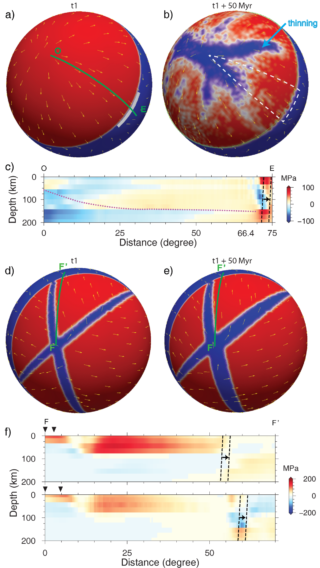What does it take to break up a supercontinent?
The forces that drive supercontinent breakup are commonly attributed to either the upward push of rising sub-continental mantle plumes and related mantle convection, or the drag force produced by retreating subduction systems along the margin of the supercontinent. The Earth Dynamics Research Group’s geodynamic modeling team recently published results of a new 4D model featuring a full analysis of these forces and an evaluation of the effect of pre-existing orogens in the lithosphere on the breakup process (Figure 1).

Our models suggest that in both homogeneous supercontinents (ones with no orogens) and supercontinents with embeded orogens, sub-supercontinent plume upwelling acts as the controlling factor on the extensional stress in the supercontinent interior, whereas subduction retreat mainly affects a zone along the margin of the supercontinent (Figure 2). Convection-induced shear stress at the bottom of the supercontinent is 1–2 orders of magnitude smaller than that of extensional stress on the lithosphere. In our two end-member models (with or without orogens), the breakup can be achieved for a supercontinent with orogens after the first surge in the extensional stress, leading to a plate-like break-up behaviour. For a hypothetical supercontinent without orogens, the rising plumes cause more diffused local thinning of the continental lithosphere before a breakup can be achieved in a less plate-like manner. Our work thus indicates that weak orogens play a critical role in determining the locations of continental rifting and the dispersal behaviour of supercontinent breakup.

Contact person: Nan Zhang, Earth Dynamics Research Group, Curtin University.
Relevant publication:
Chuan Huang, Nan Zhang, Zheng‐Xiang Li, Min Ding, Zhuo Dang, Amaury Pourteau, Shijie Zhong. Modeling the Inception of Supercontinent Breakup: Stress State and the Importance of Orogens. Geochemistry, Geophysics, Geosystems (In Press; https://doi.org/10.1029/2019GC008538).
